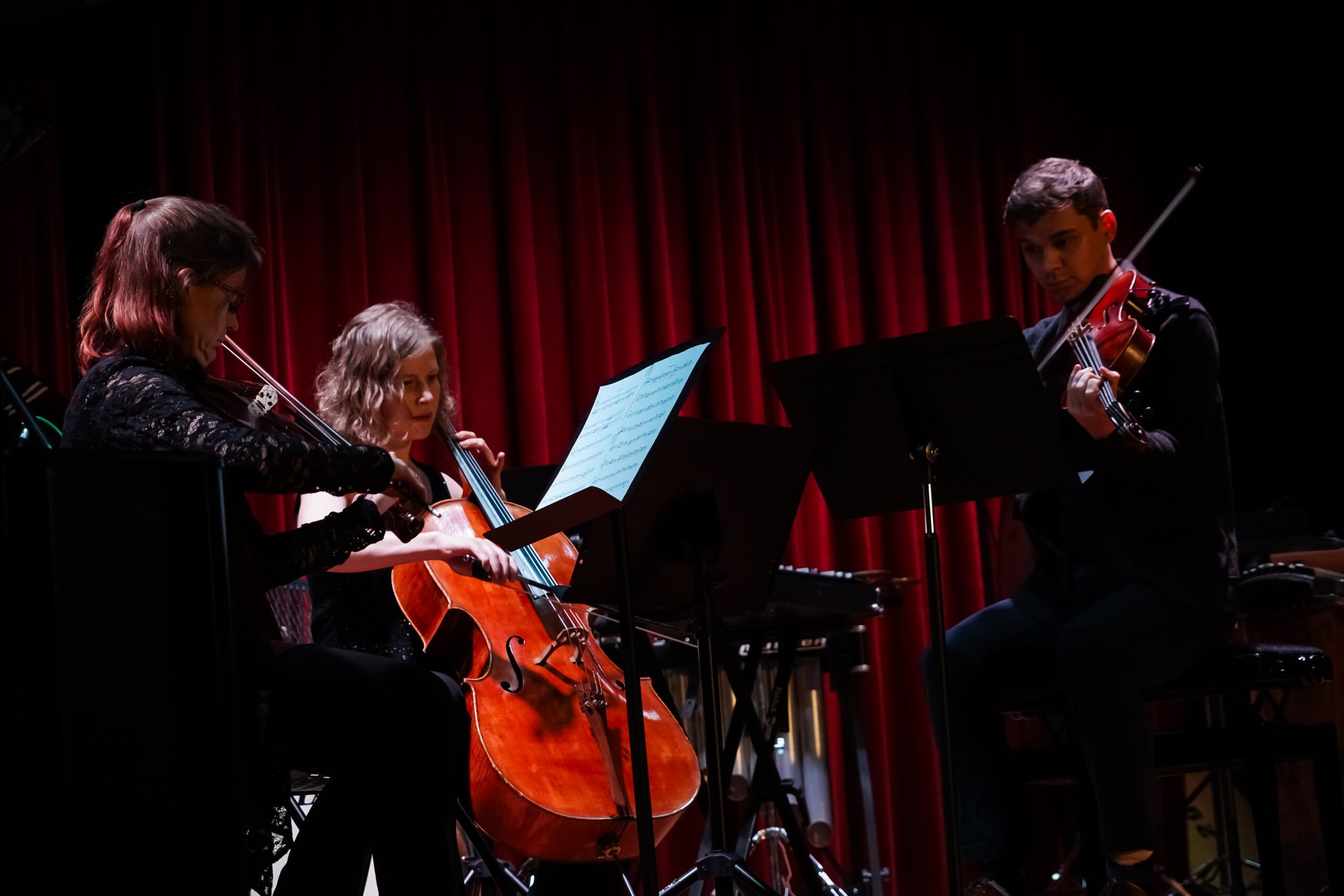
CAMPGround25 Program
Saturday, March 15 at noon, Seminole Heights Garden Center - reflection
Saturday, March 15 at noon, Seminole Heights Garden Center - reflection
Live Streaming link: https://www.youtube.com/live/Cx-aEpJrJUI?si=xmhh-OBO7N7xDH4g
강원 Kangwon
PAN Project
piri, gamin
guqin, Jeff Roberts
shakuhachi, Ned Rothenberg
janggu, Woonjung Sim
This performance ‘Kangwon’ is an improvisation based on a version of the Korean folk song Arirang from the Northeast coastal province Kangwon-do in Korea. Arirang is the most widely known folk song in Korea with 20 regional versions of the song and hundreds of variations on these regional versions. Kangwon Arirang, performed here, contains unique regional music characteristics including the use of a minor mode and a five beat asymmetrical rhythmic pattern (in contrast with the best known version of Arirang, which uses a major mode and a symmetrical rhythmic pattern). These ‘Kangwon’ music characteristics are rooted in the local improvisational components of shaman ritual music and thus provide a natural platform for expanded improvisation in this performance.
Strange, High Sky
John Liberatore https://johnsliberatore.com
violin, Sini Virtanen
Written for violinist Patrick Yim, Strange, High Sky draws inspiration from Lu Hsun’s Wild Grass. Patrick introduced me to a 1931 English translation of this marvelous collection of aphoristic stories as a way of pairing my piece with other pieces in his repertoire. Of course, I read these stories through my own western lens, but I found them extremely evocative and thought-provoking. Lu personifies non-sentient objects to express similar states of tension. For example, in The Shadow’s Leave-Taking, a shadow (your shadow) says: “I shall leave you and sink into darkness. Yet darkness will swallow me up, and light also will cause me to vanish.” Or in Dead Fire, a frozen flame knows that, if it comes to life, it will burn out, and yet it ceases to be a flame unless it burns. Change leads to nothingness, but so does stasis. Easing one tension creates new ones. I link each of the three movements in Strange, High Sky to specific stories in Lu's collection, though I hesitate to assign specific programmatic relationships between these movements and these stories in particular, nor to the objects they personify (a shadow, a tree, and a flame, respectively). Still, the tensions described in Wild Grass resonate with my musical sensibilities about things like tonality, voice-leading, and form. A point of rest can be restless. Working out one set of tensions creates others. Following one tendency belies some other resolution. Each of the three movements unfolds a web of tonal connections, pulling in different directions, suggesting resolution and tension at the same time, partly inspired by Lu's work.
unheard
Emily Koh https://www.emilykoh.net
clarinet, Calvin Falwell
saxophone, Katherine Weintraub
"I have said,
screamed and shouted,
but it remains unheard,
and you have gone."
Akerio *world premiere. This piece is written for Sini Virtanen Cabaoglu and Arda Cabaoglu Virtanen
Axel Retif https://axelretif.com
violin, Sini Virtanen
trumpet, Arda Cabaoglu
“판 PAN, March 15, 2025”
PAN Project
saenghwang, gamin
guqin, Jeff Roberts
shakuhachi, Ned Rothenberg
janggu & jing, Woonjung Sim
The essence of our ensemble is embedded in our name “판 PAN”, in Korean meaning, “a place to gather and come together’. In this spirit, PAN Project is a space where
-Short pause-
Multifacetedness
Yu-Shiuan Mei
flute, Julianna Eidle
In the process of self-exploration, I have come to realize that people (or myself, to be specific) are constructed of various contradictory elements. In different environments, people display specific behaviors, personalities, or speaking styles, giving rise to two distinct qualities: the "authentic self" and the "reflected self" influenced by the environment. These two qualities often stand in opposition to each other, creating duality. In diverse environments and circumstances, people generate multiple "reflected selves," and these "reflected selves" often contradict the "authentic self." Therefore, one contradiction coexists with another, forming a multifaceted nature that shapes people into a completer and more authentic self-image. In this piece, I utilize the pattern at the beginning to symbolize the "authentic self" and, in the course of the music's progression and development, I capture various fragments of the pattern, combining and developing them with different timbres and articulation to embody various "reflected selves.
Long, Long the pathway to cold hill
Xu Zheng
cello, Laura Usiskin
guqin & voice, Jeff Roberts
Inspired by Han Shan's poem Long, Long the Pathway to Cold Hill, this piece captures the tranquil yet desolate atmosphere of winter in Cold Hill, reflecting the Buddhist aesthetic deeply rooted in Tang Dynasty China. Han Shan, a reclusive monk and poet from that era, remains a mysterious figure, with little known about his real name or birth year, though his work has gained recognition in the West.
杳杳寒山道, 落落冷涧滨
Long, long, the path to cold hill;
Drear, drear, the waterside so chill.
啾啾常有鸟, 寂寂更无人
Chirp, chirp, I often hear the bird;
Mute, mute, nobody says a word.
淅淅风吹面, 纷纷雪积身
Gust by gust, winds cress my face;
Flake on flake, snow covers all trace.
朝朝不见日, 岁岁不知春
From day to day, the sun won’t swing;
From year to year, I know no spring.
Four Harmonies: Reflections of Monet
Justin Weiss https://www.justinweissmusic.com
flute, Julianna Eidle
clarinet, Calvin Falwell
violin, Christina Adams
percussion, Kevin von Kampen
voice, Jamie Jordan
Four Harmonies responds to a series of paintings of Monet, which I recently saw at Musée D’Orsay in Paris. The paintings were of the Rouen Cathedral and, as is typical of Monet, he painted multiple variations on the Cathedral’s façade with different hues and shadings, and he titled them various “Harmonies” depending on the colors that are primary in the painting. I wanted to translate into music this idea of taking a single subject and transforming it based on the way it is treated in with various techniques. In Four Harmonies, there are four continuous movements which are all based on closely related harmonic material. The four “harmonies” in this piece are not multiple chords or collections in a musical sense, but rather different shadings and explorations of a single subject. In this way, the piece becomes an approximation of a single subject based on multiple viewpoints, angles, or perspectives, as is the case for the Monet series. The voice in Four Harmonies does not have a text but instead uses IPA phonemes to create musical shapes with the vocal sounds. In this way, the voice not stand out from the rest of the ensemble with its importance and/or use of text and is meant to blend with the ensemble to create a true quintet among the musicians.
Technical Director: Rob Voisey & Zach Hale
Assistant Director: Indigo Knecht
Photographer: Axel Retif
Head of usher: Hannah Lanese
Partners
Sponsors
Special Thanks to Vox Novus, Creative Loafing, WSMR (Tyler Kline’s Modern Notebook), and WMNF (Peter Tush).








